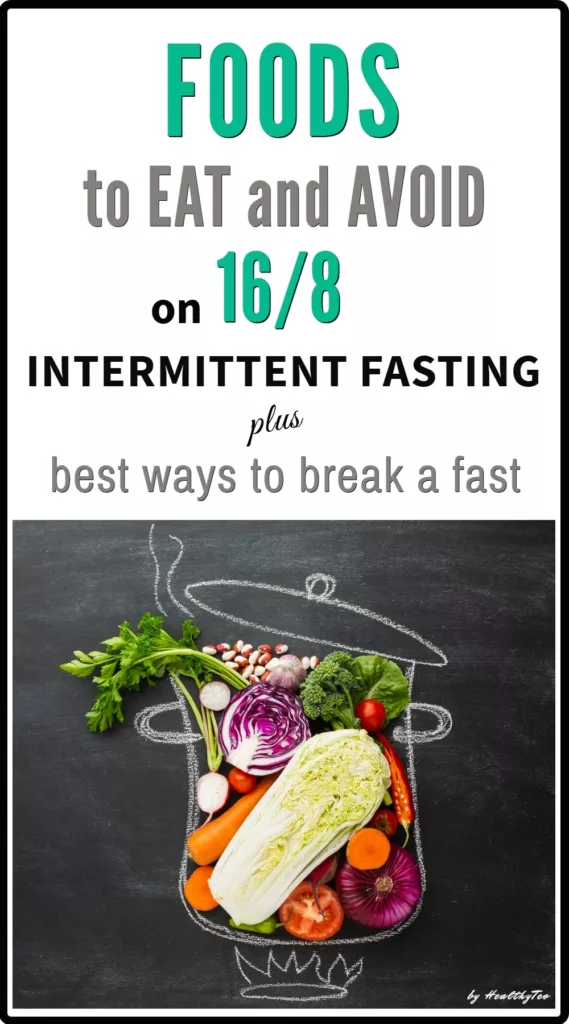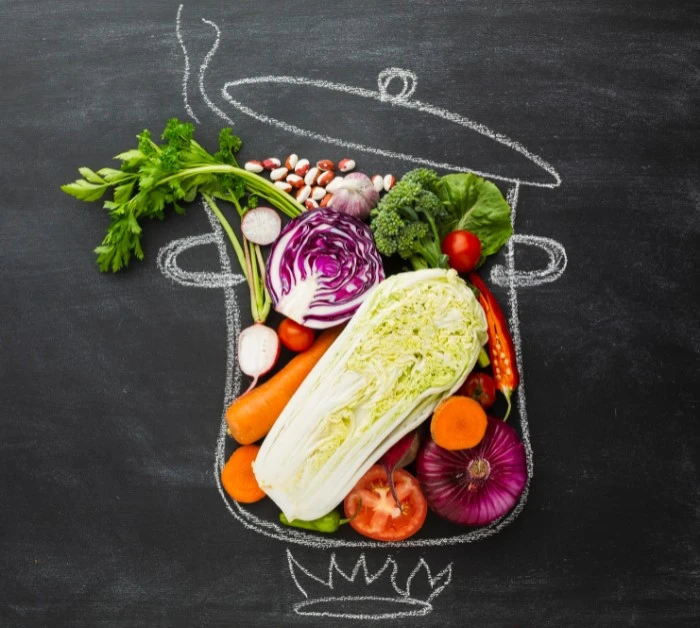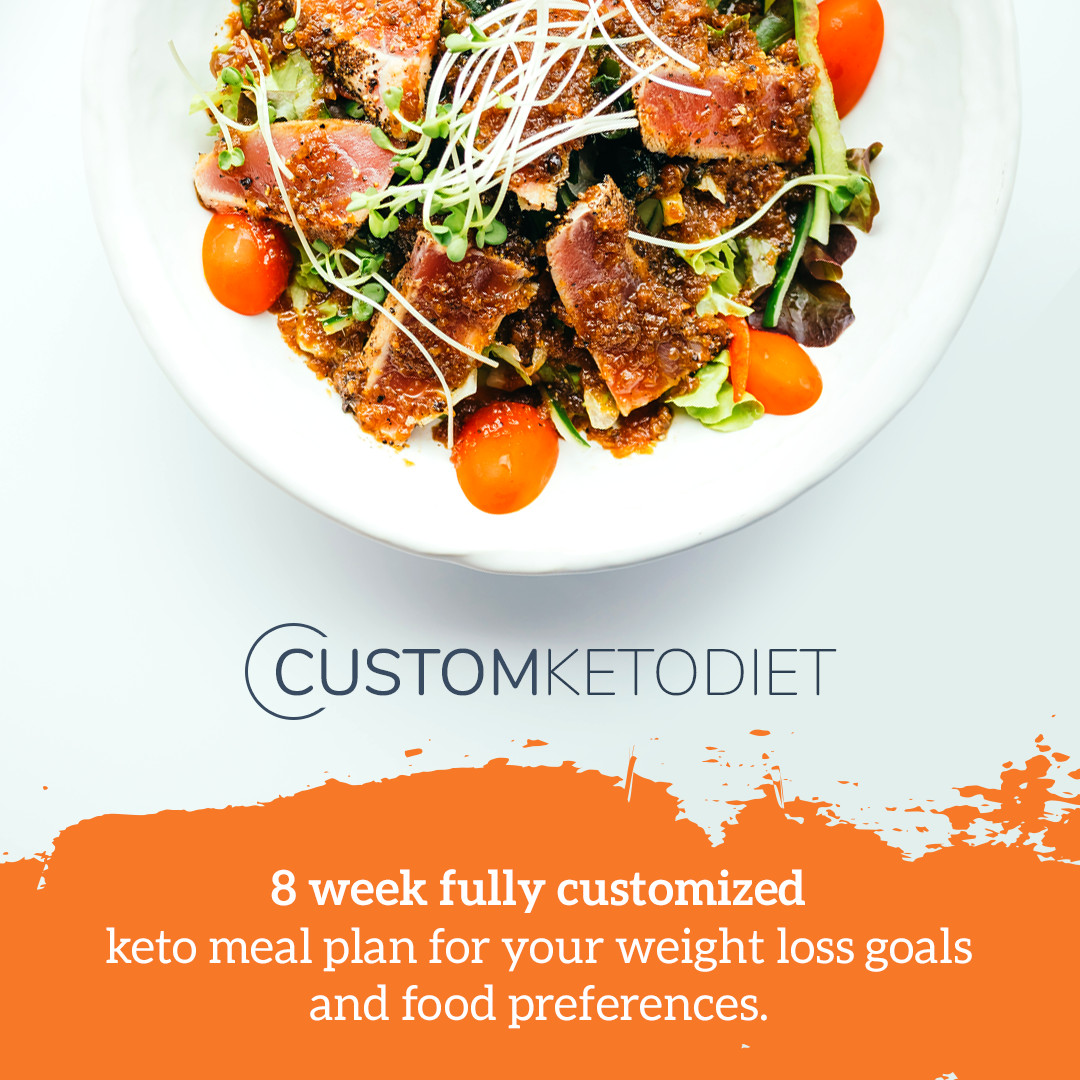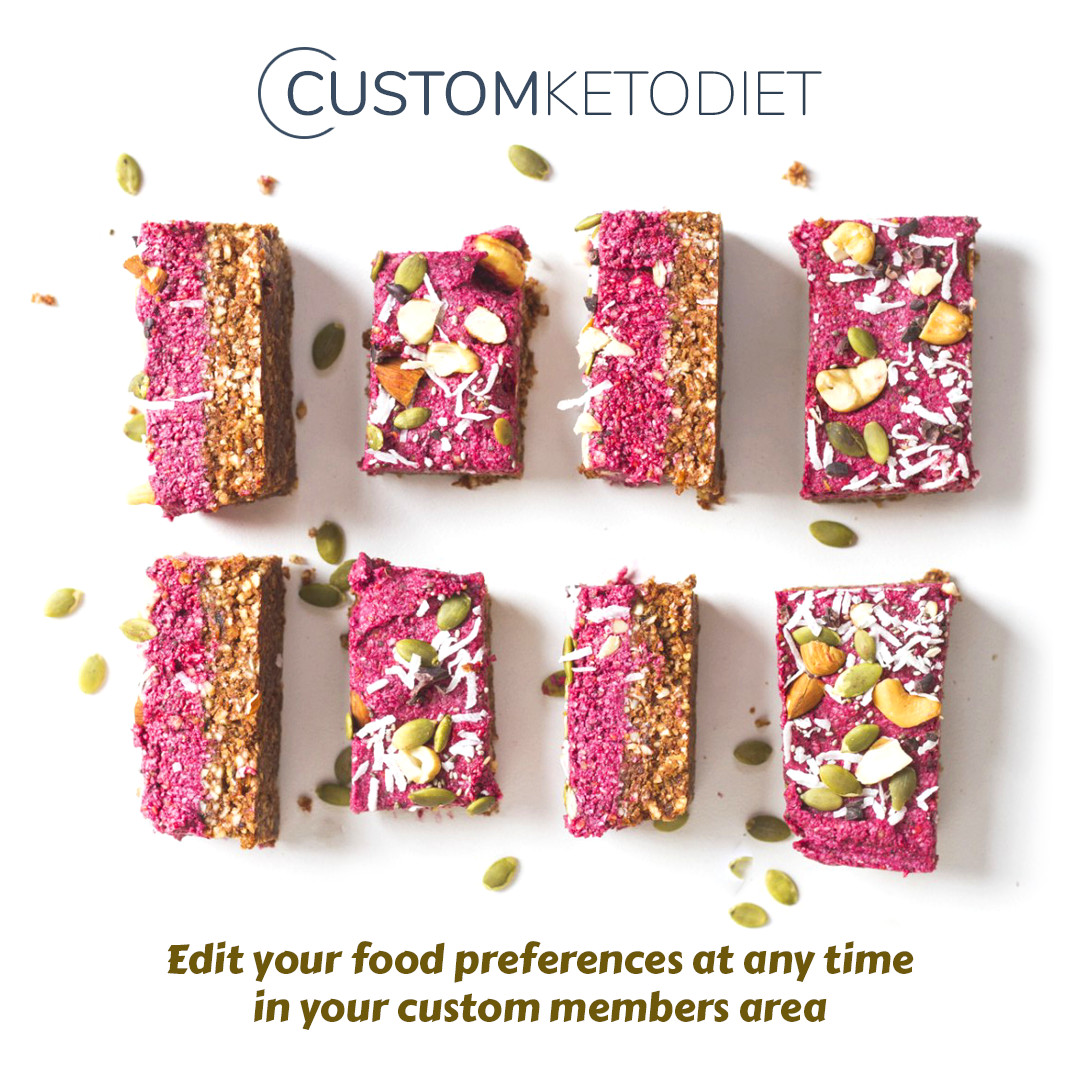16/8 intermittent fasting food list: What to eat and avoid during eating hours and how to break a fast
There are plenty of foods allowed to eat on 16/8 intermittent fasting during an 8-hour eating window. The great thing about intermittent fasting is that you can eat any kind of food (almost any, you need to avoid some foods) and that is the reason why intermittent fasting methods are so popular today.
In this article, we will present to you what to eat and drink on intermittent fasting, foods, and drinks to avoid, and the best ways to break a fast.
This post may contain affiliate links, which means we may receive a small commission, at no cost to you, if you make a purchase through a link. For more information, please see our disclosure.
Foods to eat when following a 16/8 intermittent fasting method
When it comes to what foods to eat on 16/8 intermittent fasting the best thing is that there are no food rules or restrictions, or maybe just some rules that you need to stick to.
The advantage of intermittent fasting no matter what method you will choose (the 5:2 diet, alternate-day fasting, the warrior diet, or the eat-stop-eat diet) is that you don’t have to waste time on calorie counting or monitoring your intake of carbs.
But you need to follow some rules. It is recommended to limit intake of junk and processed foods. As you know these foods are associated with weight gain and an increased risk of diseases such as obesity and heart disease.
Theoretically, you can eat anything you want in the 8-hour eating window but by doing this you won’t see any results. People often reward themselves after fasting hours with junk food, thereby alternate-day fasting is incredibly popular.
No matter what intermittent fasting method you choose to follow there are two things that you need to remember:
- You should aim eating more healthy and quality food during eating hours
- Discipline is mandatory
If you do intermittent fasting and you eat junk and processed foods during the eating period you won’t see any results, no matter if you are doing this to lose some weight or to improve your health.
So picking the right foods on the 16/8 intermittent fasting method or any other IF method is crucial.
List of foods to eat on 16/8 intermittent fasting
The main foods that you should be sure to eat on a 16/8 intermittent fasting diet are:
- Fruits
- Vegetables
- Lean Protein
- Healthy fats
Lean protein
Protein is an essential part of a balanced diet. The Recommended Daily Allowance (RDA) of protein is 0.8 grams of protein per kg of body weight.
The RDA is a minimum amount of a nutrient you need to meet your basic nutritional requirements. It is the minimum amount you need to keep from getting sick – not the specific amount you are supposed to eat every day.
To calculate your daily protein intake you can simply multiply your weight in pounds by 0.36 or you can use this protein calculator.
The 16/8 intermittent fasting food list for protein include:
- Poultry and white-flashed fish
- Seafood and shellfish
- Eggs
- Dairy products: plain greek yogurt, low-fat cottage cheese, low-fat milk
- Seeds and nuts
- Whole grains
- Beans and legumes
- Tofu and tempeh
Here are some examples of all these food groups. You should include all the foods that belong to these food groups we will show you just some examples of them.
White-Flashed Fish
White-flashed fish is a super lean and excellent protein source. It provides around 20-25 grams of protein per 3.5-ounces (100g) plain, cooked serving.
Examples of lean white fish include cod, haddock, flounder, pollock, halibut, tilapia. These are just examples, any kind of fish is good to include in your meals on a 16/8 intermittent fasting.
Seafood and shellfish
When it comes to lean animal protein seafood is another food choice. Salmon is a particularly good choice in the seafood aisle, as 1 oz has 5.8 g of protein. Salmon is not the only lean protein seafood.
Tuna falls in this category too and tuna is among the highest protein sources among fish. According to the USDA 100 grams of canned light tuna in water, with the solids drained has 20.3 g of protein.
Shellfish are also rich in lean protein, healthy fats, and minerals. You can include in your eating window any kind of shellfish like shrimp, crab, lobster, crayfish scallops, oysters, or mollusks.
Be careful if you decide to include shellfish in your meals because they are one of the top 8 food allergens in the U.S. People with a shellfish allergy must exclude all shellfish from their diet to avoid having an allergic reaction.
Poultry
Poultry meat (chicken, turkey, duck, geese) like other meats, milk, and eggs has a protein component usually defined as high quality.
According to the USDA, one small skinless chicken breast contains 31.1 g of protein. Chicken is one of the most popular types of food. It’s not only widely available and easy to prepare but also easily found in a number of preparations and varieties.
Just 2 thick slices (84 grams) of turkey pack 24 grams of protein. Always choose unprocessed turkey over-processed forms. Processed varieties may harbor large amounts of salt. Sodium is usually added as either a preservative or flavor enhancer.
Dairy products
Plain greek yogurt – A 6-ounce serving of Greek yogurt packs 15-20 grams of protein, compared to only 9 grams in a serving of regular yogurt.
This is due to how Greek yogurt is made. It’s strained to remove the liquid whey, leaving a more concentrated product with more protein that is also thicker and creamier.
Low-fat cottage cheese – Cottage cheese is a high-protein food. A 4-ounce or 113 grams serving of low-fat cottage cheese provides about 13 grams of protein.
Today cottage cheese is incredibly available, the newest trends include single-serving containers, flavored options, and the addition of live and active probiotic cultures.
Low-fat milk – Consuming low-fat milk is an easy way to get protein. An 8-ounce (240 ml) serving of low-fat milk with 1% milkfat has 8 grams of protein.
Beans and legumes
Beans and legumes are a lean plant-based protein that is naturally cholesterol-free and also high in fiber, folate, and phytates, which are plant-based antioxidants.
They are also a good source of B vitamins and a great replacement for meat as a source of vegetarian protein.
Most beans provide between 29-36% of the DV for protein per cup cooked. Boiled soybeans (or edamame) provide a whopping 63% DV.
Here is a small list of the top beans and legumes highest in protein that you should include in your 16/8 intermittent fasting meals.
- Boiled soybeans (Edamame)
- Lentils
- Large white beans
- Split peas
- Cranberry beans
- Pinto beans
- Kidney beans
- Black beans
- Navy beans
- Lima beans
- Chickpeas
- Peanuts (Dry Roasted)
These are beans and legumes highest in protein but you should include also the other beans and legumes.
Why legumes are very important to include in your meals while fasting? – According to a study published in Clinical Diabetes, legumes have been shown to reduce the risk of type 2 diabetes, lower high blood pressure, and help control weight.
Although research supports the benefits of legume consumption only 8% of U.S. adults report eating legumes on any given day. So be sure to include legumes in your meals, they are very good for you.
Whole grains
Many people think that the only advantage of whole grains is their high fiber content. But did you know that most whole grains are a great protein source too?
Whole unrefined grains provide more protein for each carb because the bran and germ of grains contain the most protein per carb.
High protein grains that you should include in your 16/8 intermittent fasting diet:
If you want to know more, here you can find out how much protein is in different popular whole grains, when you eat them as a side dish.
Nuts and seeds
Nuts and seeds are good sources of protein, healthy fats, fiber, vitamins, and minerals.
Nuts are a versatile, good source of plant-based protein, especially for those who eat few or no animal products.
While all nuts contain protein and you should include different types of nuts in your eating time when fasting here is the list of 8 nuts with the highest protein content:
- Almonds
- Walnuts
- Pistachios
- Cashews
- Pine nuts
- Brazil nuts
- Peanuts
- Hazelnuts
Seeds – There are many different types of seeds and we mostly include them in our diet as a good source of fiber and healthy fats. But seeds are also a good source of protein, vitamins, and minerals.
For example, by weight hemp seeds provide similar amounts of protein as beef and lamb, so 2-3 tablespoons of hemp seeds provide about 11 grams of protein. They are considered a complete protein source which means they provide all essential amino acids.
A tablespoon of chia seeds provides about 3 grams of protein. It’s a complete protein but these seeds are also a great source of omega-3 fatty acids, carbs, fiber, antioxidants, vitamins, and minerals.
Here is a list of edible seeds high in protein:
- Pumpkin seeds
- Hemp seeds
- Sunflower
- Flax seeds
- Chia seeds
- Sesame seeds
Tofu and tempeh
Tofu – If you avoid animal products tofu is a viable protein source. Each 3 oz of tofu has 8 grams of protein, 79 calories, 4.5 grams total fat according to the USDA.
Tofu comes in different textures. You can use firm or extra-firm tofu in place of meat that you’d bake, grill or saute. Soft or silken tofu can be used in creamy soups or desserts.
Tempeh – This is a fermented soy product that is mainly popular among vegetarians as a meat replacement. Tempeh is high in protein, vitamins, and minerals but low in sodium and carbs.
Because it is more compact than other soy products tempeh provides more protein than some other vegetarian alternatives.
Tempeh is typically marinated or seasoned to increase flavor, then crumbled, baked, steamed, or sauteed and added to dishes. Here you can find out more about tempeh and how to cook it!
Eggs
According to the USDA, one large whole egg contains 6.24 g of protein, 74 calories, 5 g of total fat. Eggs are very nutritious and they contain a little bit of almost every nutrient you need.
They also contain all the essential amino acids in the right ratios, so your body is well equipped to make full use of the protein in them.
Fruits
Fruits are typically packed with vitamins, minerals, phytonutrients, and fiber. Fruits should be very important for your meals during the eating time while following the 16/8 intermittent fasting method.
Always look for fresh fruits, try to avoid canned fruits or juice, because of the concentrated amounts of sugars per serving.
You can eat a handful of fruits during your eating window on intermittent fasting. Any fruit is allowed, here is a shortlist of fruits you should look to consume when intermittent fasting:
- Apples
- Avocado
- Apricots
- Blueberries
- Blackberries
- Bananas
- Cherries
- Dates
- Peaches
- Pears
- Plums
- Oranges
- Melons
Vegetables
Nutrient-dense, high fiber vegetables are as important when following an intermittent fasting protocol as they are when you are following any other diet.
You can include any vegetable in your meals, here are some examples of veggies to include in your eating period while IF:
- Asparagus
- Broccoli
- Celery
- Bok choy
- Peppers
- Leafy greens (kale, lettuce, spinach, arugula)
- Cauliflowers
- Mushrooms
- Brussel sprouts
- Zucchini
- Cabbage
- Green beans
- Radish
- Artichoke
- Olives
- Onion
- Carrots
- Tomatoes
- Fermented vegetables
Healthy fats
Dietary Guidelines for Americans 2015-2020 recommends that fats should contribute 20-35% of your daily calories. Saturated fat should not contribute more than 10% of daily calories. Red meat, whole milk, and baked goods contain high amounts of saturated fat.
Healthy fats include monounsaturated and polyunsaturated fats. High-quality fats to include in your intermittent fasting protocol include:
- Grass-fed butter
- Ghee
- Lard
- MCT oil
- Olive oil
- Sesame oil
- Avocado oil
- Canola oil
Carbs on 16/8 intermittent fasting
Carbs are the major source of energy for your body. There are three different types of carbohydrates: starches, fiber, and sugars.
For instance, fiber is a carbohydrate that aids in digestion, helps you feel full, and keeps blood cholesterol levels in check.
Carbs often get a bad reputation for causing weight gain. Not all carbs are created equal and they are not inherently fattening. You should choose foods that are high in fiber and starch but low in sugars.
By including fruits, vegetables, whole grains, seeds – carbs are already part of intermittent fasting. So the question is not should I eat carbs during the eating time on IF but what are some healthy sources of carbohydrates?
Healthy carbohydrate-rich foods include:
- Whole grains: quinoa, amaranth, brown rice, oatmeal, barley, whole grain pasta
- Fruits
- Starchy vegetables: sweet potatoes, yams, corn, peas and carrots
- Non-strachy vegetables
- Legumes: lentils, black beans, pinto beans, navy beans, chick peas and soybeans
- Milk products: low-fat milk, plain yogurt
- Nuts and seeds
- Soy milk and tofu
What to drink during 16/8 intermittent fasting?
During your fasting window, you can’t consume food but you should consume drinks. Drinks with calories higher than single digits can break your fast and undo your effort.
So it is very important to know what to drink during your fasting and non-fasting time when you can eat. Here are some drinks that you can consume and you should consume more drinks while fasting to stay hydrated!
- Water
- Mineral water
- Tea
- Coffee (black, don’t add sugar, cream or milk)
- Bone broth
- Herbal tea
Drinks to avoid while fasting
It is always good to avoid drinks with sugar and artificial sweeteners. There isn’t a rule that says you can’t drink soda, juice, or milkshake during your eating window, but when it comes to your fasting period there are some drinks that you must avoid.
During your fasting time you should avoid:
- Diet soda (contains artificial sweeteners)
- Juice
- Coconut water
- Alcohol
Two main things that you need to remember for drinks while fasting is to make sure you are drinking enough fluids and to avoid drinks that contain calories.
Caloric drinks like juices, smoothies, diet soda can be consumed during your eating window, but if you can it is best to stick to water, tea, coffee, or mineral water.
To learn more about drinks while intermittent fasting, here is a detailed article with all drinks to consume and avoid during the fasting window.
Foods to avoid on 16/8 intermittent fasting
During your eating window on any method of intermittent fasting, you should stick to the foods presented above. Foods that you need to exclude from the IF food list are:
- Candy (gummies, bars, chews, etc.)
- Baked goods (cake, muffins, cupcakes, brownies, cookies)
- Fried foods (french fries, fried chicken, etc.)
- Low-quality snacks (potato chips, corn chips, etc.)
All processed foods, junk food, refined grains, trans-fat, processed meat, candy bars should be excluded from your list of foods for the 16/8 intermittent fasting method or any other IF protocol.
What to eat to break your 16 hour fast
When it is time to break your fast it is best to start with smaller portions of food that are easily digested so you don’t overwhelm your digestive system.
Nutrient-dense foods that are easy to digest that contain protein and some healthy fats can break your fast more gently.
We know that you will be hungry after 16 hours of not eating but the worst thing to do here is to break your fast with processed or junk food that is full of fat, carbs, sugar, etc.
Always prepare something that is easily digestible and nutritious. Here are some foods that will help you to break your 16 hour fasting period:
Soups – You will know what time your fasting ends. Prepare a soup that contains protein and easily digestible carbs, such as lentils, tofu. Avoid soups with heavy creams or large amounts of raw vegetables.
Smoothies – Great option to introduce nutrients to your body since smoothies contain less fiber, than whole raw vegetables and fruits.
Dried fruits – Apricots, raisins, dates. Dates are often used to break a fast. They are healthy, nutritious, and very sweet. Learn more about the benefits of dates here!
Fermented foods – Kefir or yogurt are also good drinks to break a fast.
Avocados – This fruit can be the first choice to eat after fasting for 16 hours.
So when you are ready to break your 16 hour fasting time and start eating first focus on easily tolerated foods that can help replenish important nutrients and electrolytes.
After consuming these easily digestible foods give yourself a break and you can start eating whatever you want from the healthy foods presented above.
Final thoughts about the foods to eat and avoid on 16/8 intermittent fasting
As you can see from all mentioned above there are many foods to eat on 16/8 intermittent fasting.
You can eat fruits, vegetables, lean protein, healthy fats. Also, from the drinks, you can choose water, tea, coffee, herbal teas, mineral water, bone broth.
Always avoid processed foods, junk food, and drinks with sugar and artificial sweeteners.
Be prepared when your 16 hour fasting period ends, make yourself a smoothie, or pick dried fruits to break your fast. Always go for easily digestible foods to break your fast.
Healthy eating during intermittent fasting is the key to preventing nutritional deficiencies. As with any other eating pattern you should be aware of the possible side effects of IF.
Learn more about the intermittent fasting side effects here!
If you are new to intermittent fasting and never tried it before it is always good to consult with your doctor or nutritionist before starting.
They know what is best for you and is the intermittent fasting right choice for you!





